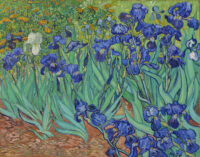 Irises by Vincent van Gogh is one of the most popular artworks in the collection of the Getty Museum. Van Gogh painted Irises in May of 1889, a week after he was voluntarily committed to an asylum in Saint-Rémy. He painted from life the irises in the asylum’s garden, capturing their dynamic curving lines with his characteristic thick impasto. He would create 130 paintings during his stay at the asylum. As the first work from this intense period, Irises is of great significance in the Van Gogh oeuvre.
Irises by Vincent van Gogh is one of the most popular artworks in the collection of the Getty Museum. Van Gogh painted Irises in May of 1889, a week after he was voluntarily committed to an asylum in Saint-Rémy. He painted from life the irises in the asylum’s garden, capturing their dynamic curving lines with his characteristic thick impasto. He would create 130 paintings during his stay at the asylum. As the first work from this intense period, Irises is of great significance in the Van Gogh oeuvre.
The Getty acquired it in 1990 and it has been on display ever since. It has never traveled; never been taken down. The museum’s long closure due to COVID-19 has given Getty staff the opportunity to remove the painting to the conservation lab for an unprecedented in-depth study to investigate Van Gogh’s process in the creation of Irises.
“We developed a plan to examine the painting in many different lights which will add to our understanding of the artist’s studio practice and we hope that the results of this research will enhance the appreciation for the painting’s undisputed beauty,” said Devi Ormond, associate conservator of paintings at the Museum, who came to the Getty from the Van Gogh Museum more than nine years ago and has always wanted to thoroughly study the painting. “A ray of sunshine, for me, during these dark times has been having Irises in the conservation studio.”
Some of the goals of the study are to gain a better understanding of what pigments van Gogh used, and whether or not they have changed or degraded over time. It might also be possible to learn more about how he planned out the composition, the different types of plants depicted in the painting, and how they relate to the garden at the Saint-Paul-de-Mausole asylum in Saint-Rémy-de-Provence, which the artist had entered just a week before making Irises. […]
Getty scientists and conservators started by examining the painting using a variety of non-invasive imaging techniques. Stereo-microscopy gave a highly magnified view of the surface of the painting, allowing the complex mixture of pigments in each stroke to be visualized. Infrared reflectography and x-radiography provided a way of looking through the layers of the painting, revealing preparatory layers or changes. Macro x-ray fluorescence scanning allowed the chemical elements in the painting to be identified and visualized, from which the pigments could be inferred.
The Getty reopens on Tuesday, May 25th, and Irises will go back on the wall. The data collection will be examined in exhaustive detail and be compared to other works by Vincent van Gogh in the Getty and other museums around the world.